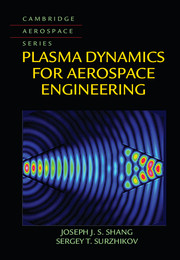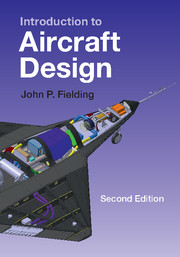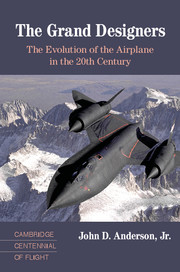Refine search
Actions for selected content:
2075 results in Aerospace engineering
9 - Radiative Energy Transfer
-
- Book:
- Plasma Dynamics for Aerospace Engineering
- Published online:
- 20 June 2018
- Print publication:
- 21 June 2018, pp 304-341
-
- Chapter
- Export citation
7 - Plasma and Magnetic Field Generation
-
- Book:
- Plasma Dynamics for Aerospace Engineering
- Published online:
- 20 June 2018
- Print publication:
- 21 June 2018, pp 225-265
-
- Chapter
- Export citation
Copyright page
-
- Book:
- Plasma Dynamics for Aerospace Engineering
- Published online:
- 20 June 2018
- Print publication:
- 21 June 2018, pp vi-vi
-
- Chapter
- Export citation
5 - Magnetohydrodynamics Equations
-
- Book:
- Plasma Dynamics for Aerospace Engineering
- Published online:
- 20 June 2018
- Print publication:
- 21 June 2018, pp 146-184
-
- Chapter
- Export citation
Preface
-
- Book:
- Plasma Dynamics for Aerospace Engineering
- Published online:
- 20 June 2018
- Print publication:
- 21 June 2018, pp xi-xiv
-
- Chapter
- Export citation
1 - Plasma Physics Fundamentals
-
- Book:
- Plasma Dynamics for Aerospace Engineering
- Published online:
- 20 June 2018
- Print publication:
- 21 June 2018, pp 1-35
-
- Chapter
- Export citation
10 - Applications
-
- Book:
- Plasma Dynamics for Aerospace Engineering
- Published online:
- 20 June 2018
- Print publication:
- 21 June 2018, pp 342-382
-
- Chapter
- Export citation
6 - Ionization Processes in Gas
-
- Book:
- Plasma Dynamics for Aerospace Engineering
- Published online:
- 20 June 2018
- Print publication:
- 21 June 2018, pp 185-224
-
- Chapter
- Export citation
Contents
-
- Book:
- Plasma Dynamics for Aerospace Engineering
- Published online:
- 20 June 2018
- Print publication:
- 21 June 2018, pp vii-x
-
- Chapter
- Export citation
Appendix: Physical Constants and Dimensions
-
- Book:
- Plasma Dynamics for Aerospace Engineering
- Published online:
- 20 June 2018
- Print publication:
- 21 June 2018, pp 383-384
-
- Chapter
- Export citation
2 - Plasma in a Magnetic Field
-
- Book:
- Plasma Dynamics for Aerospace Engineering
- Published online:
- 20 June 2018
- Print publication:
- 21 June 2018, pp 36-70
-
- Chapter
- Export citation
4 - Plasma Dynamics Formulation
-
- Book:
- Plasma Dynamics for Aerospace Engineering
- Published online:
- 20 June 2018
- Print publication:
- 21 June 2018, pp 108-145
-
- Chapter
- Export citation

Plasma Dynamics for Aerospace Engineering
-
- Published online:
- 20 June 2018
- Print publication:
- 21 June 2018

Applied Computational Aerodynamics
- A Modern Engineering Approach
-
- Published online:
- 28 May 2018
- Print publication:
- 27 April 2015
-
- Textbook
- Export citation

Jet Propulsion
- A Simple Guide to the Aerodynamics and Thermodynamic Design and Performance of Jet Engines
-
- Published online:
- 28 May 2018
- Print publication:
- 22 July 2015
-
- Textbook
- Export citation

Introduction to Aircraft Design
-
- Published online:
- 28 May 2018
- Print publication:
- 03 April 2017
-
- Textbook
- Export citation

The Grand Designers
- The Evolution of the Airplane in the 20th Century
-
- Published online:
- 27 April 2018
- Print publication:
- 22 March 2018
Copyright page
-
- Book:
- The Grand Designers
- Published online:
- 27 April 2018
- Print publication:
- 22 March 2018, pp vi-vi
-
- Chapter
- Export citation
Appendices
-
- Book:
- The Grand Designers
- Published online:
- 27 April 2018
- Print publication:
- 22 March 2018, pp 289-296
-
- Chapter
- Export citation
3 - Setting the Gold Standard
-
- Book:
- The Grand Designers
- Published online:
- 27 April 2018
- Print publication:
- 22 March 2018, pp 44-67
-
- Chapter
- Export citation
